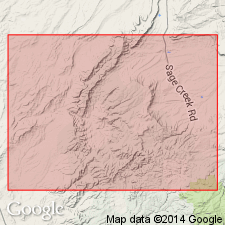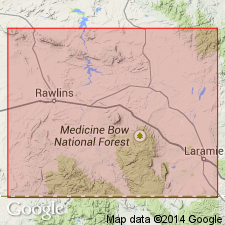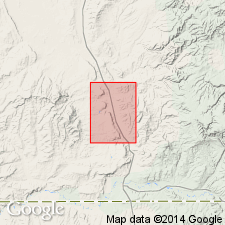
- Usage in publication:
-
- Dad member
- Modifications:
-
- Named
- Dominant lithology:
-
- Sandstone
- Shale
- AAPG geologic province:
-
- Green River basin
Summary:
Named as a member of the Upper Cretaceous Lewis shale for development in the Union Texas Gas Company Dad Unit No. 2 Well located in sec 13, T16N, R93W, Carbon Co, WY, Greater Green River basin. Is a series of sandstones and minor shales 1,000-1,400 ft thick that divides the Lewis into upper and lower shales. [Very vague description.] Lies between 6,385 and 7,805 ft in Dad Unit 2 well which was not specifically designated as the type section. May be an off-shore marine facies. Of Late Cretaceous, Maestrichtian age.
Source: GNU records (USGS DDS-6; Denver GNULEX).

- Usage in publication:
-
- Dad Sandstone Member*
- Modifications:
-
- Principal reference
- AAPG geologic province:
-
- Green River basin
Summary:
Assigned as the middle member of Lewis Shale in Hanna basin, Carbon Co, WY in the Greater Green River basin. Principal reference section designated in NW1/4 NE1/4 SW1/4 sec 28, T15N, R91W, where 585 ft were measured. Reference section designated in SW1/4 SW1/4 sec 13 and SE1/4 SE1/4 sec 14, T22N, R89W, where it is 725 ft thick. Both sections are in Carbon Co. Composed of yellowish-gray, very fine grained sandstone and gray- to olive-gray shale at the measured section where it overlies the lower part and underlies the upper part of the Lewis. Can be traced north along the east margin of the Washakie and Great Divide basins. Probably deposited as a result of uplift in central WY. Assigned to the early Maestrichtian or Late Cretaceous. Correlation with other units of this age in south-central WY shown on table 1.
Source: GNU records (USGS DDS-6; Denver GNULEX).

- Usage in publication:
-
- Dad Sandstone Member*
- Modifications:
-
- Mapped 1:24k
- Dominant lithology:
-
- Sandstone
- Shale
- AAPG geologic province:
-
- Green River basin
Summary:
Sheet 1 (geol. map). Dad Sandstone Member of Lewis Shale. Mapped in area of Principal reference section, in secs. 27 and 28, T. 15 N., R. 91 W., northwest corner Peach Orchard Flat 7.5-min quadrangle, Carbon County, southernmost Wyoming. Pale-yellowish-gray, very fine-grained sandstone interbedded with olive-gray sandy shale. Thickness 585 feet. Age is Late Cretaceous. Report includes geologic map, measured sections, correlation chart, cross sections.
Source: Publication.
For more information, please contact Nancy Stamm, Geologic Names Committee Secretary.
Asterisk (*) indicates published by U.S. Geological Survey authors.
"No current usage" (†) implies that a name has been abandoned or has fallen into disuse. Former usage and, if known, replacement name given in parentheses ( ).
Slash (/) indicates name conflicts with nomenclatural guidelines (CSN, 1933; ACSN, 1961, 1970; NACSN, 1983, 2005, 2021). May be explained within brackets ([ ]).

